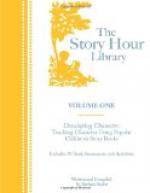“Treat me at least with honesty, my good woman!” he cries in his spirit. “Read me lessons if you will, but do not make a pretense of amusing me at the same moment!”
This obvious attitude of criticism is very disagreeable to you, but never mind, it will be a salutary lesson. Did you think, O clumsy visitor in childhood land, that simply because you called your stuffed dolls “Prince” and “Princess” you could conduct them straight through the mineral kingdom, and allow them to converse with all the metals with impunity? Nest time make your scientific fact an integral part of the story, and do not try to introduce too much knowledge in one dose. All children love Nature and sympathize with her (or if they do not, “then despair of them, O Philanthropy!"), and all stories that bring them nearer to the dear mother’s heart bring them at the same time nearer to God; therefore lead them gently to a loving observation of
“The
hills
Rock-ribbed and ancient as the sun; the vales
Stretching in pensive quietness between;
The venerable woods; rivers that move
In majesty, and the complaining brooks
That make the meadows green.”
Stories bring the force of example to bear upon children in the very best possible way. Here we can speak to the newly awakened soul and touch it to nobler issues. This can be done with very little of that abstract moralizing which is generally so ineffective. A moral “lugged in” by the heels, so to speak, without any sense of perspective on the part of the Story-Teller, can no more incline a child to nobler living than cold victuals can serve as a fillip to the appetite. The facts themselves should suffice to exert the moral influence; the deeds should speak louder than the words, and in clearer, fuller tones. At the end of such a story, “Go thou and do likewise” sounds in the child’s heart, and a new throb of tenderness and aspiration, of desire to do, to grow, and to be, stirs gently there and wakes the soul to higher ideals. In such a story the canting, vapid, or didactic little moral, tacked like a tag on the end, for fear we shall not read the lesson aright, is nothing short of an insult to the better feelings. It used to be very much in vogue, but we have learned better nowadays, and we recognize (to paraphrase Mrs. Whitney’s bright speech) that we have often vaccinated children with morality for fear of their taking it the natural way.
It is a curious fact that children sympathize with the imaginary woes of birds and butterflies and plants much more readily than with the sufferings of human beings; and they are melted to tears much more quickly by simple incidents from the manifold life of nature, than by the tragedies of human experience which surround them on every side. Robert Louis Stevenson says in his essay on “Child’s Play,” “Once, when I was groaning aloud with physical pain, a young gentleman came into the room and nonchalantly inquired




